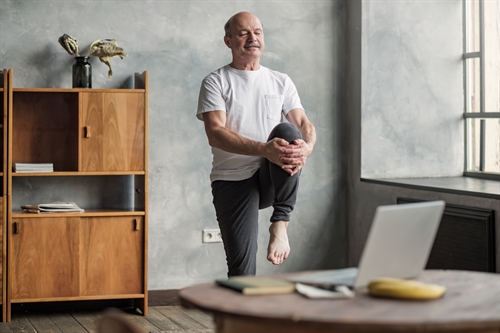An active lifestyle has so many benefits: it can improve your sleep, boost your energy levels and help with back pain or joint pain. Taking time to move can also reduce the risk of dementia, some cancers, heart disease and type 2 diabetes.
The NHS recommends at least 150 minutes of moderate physical activity a week – that’s just 20 to thirty minutes a day. Exercise does require a bit of effort, so anything you can do to make it convenient means you’re more likely to get your minutes in. For example, you might find it easy to skip the gym because you don’t want to leave the house; but a 20-minute home workout followed by a shower in your own bathroom could be doable.
What type of movement do you enjoy?
There are plenty of different ways to move – whether it’s a yoga routine, using an exercise bike or having a private kitchen disco, all will bring benefits. Opting for activity that you enjoy and look forward to will make it easier to commit to increasing the amount of exercise you do every day.
What exercise equipment do you need?
There are plenty of exercise routines you can do at home with minimal equipment – for example, yoga in its most basic form requires only a mat. But if you want to challenge yourself, you might look for weights, a step, straps, resistance bands or even an exercise machine.
How does exercise equipment fit in your home?
Thoughtful storage will keep your equipment in one place so that it’s ready and waiting for you at exercise time. It will also allow you to quickly pack up at the end of your exercise session so that your equipment is not in the way when you want to relax.
Some types of exercise equipment are more home-friendly than others. For example, you can get yoga bricks and rollers made from cork, which is easier on the eye than the traditional bright foam.
Exercise bikes and cross-trainers are not very attractive in a living space, but you may find it motivating if you can see your exercise equipment as you go about your day. And you might be more willing to get started with a training session if you know you’ve got something interesting to look at while you exercise – whether that’s the TV, or a great view through the window.
Getting help with exercising at home
Some personal trainers will specialise in routines you can do at home. But there are also apps and videos with training you can do in the living room. The NHS has some good resources to start you off with doing more activity.
Using the space you already have for an active lifestyle
It may be possible to get the space you need for exercise by shifting some furniture around. If all you require is enough space for a yoga mat, then perhaps moving the coffee table to one side will give you the room. Putting casters on furniture will make it easier to quickly shift things around to make room to stretch out on the floor, or have a dance.
Look out for furniture that no longer needs to be in your living space – for example a dresser or cupboard where you’ve stashed things you don’t use very often, like out-of-season clothing. Domestic goods that you want, but only use periodically could be kept outside the house in a self-storage unit. Some self-storage units come with insurance included – but you don’t have to accept your storage company’s own insurance if you think it doesn’t give good value. It’s worth getting a few quotes for self-storage insurance to make sure you’re not overpaying each month.
A bit of space and a bit of motivation
With some extra space and a few bits of basic equipment, you could have all the benefits of a healthier, more active lifestyle in 2025.


